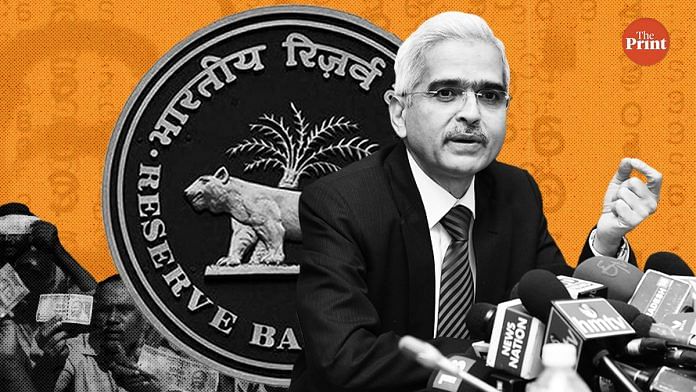RBI Monetary Policy Committee cut the interest rate by 25 basis points Thursday, and changed its policy stance from ‘neutral’ to ‘accommodative’. However, public sector banks have been reluctant to pass on these rate cuts.
ThePrint asks – Can transmission happen unless public sector banks are reformed?
Transmission won’t improve in a quarter or two but over a period of time as banking system is reformed
 Anubhuti Sahay
Anubhuti Sahay
Senior Economist, Standard Chartered Bank
We expect improved transmission on two accounts. First, the RBI’s third consecutive policy rate cut of 25 basis points since February 2019, and the monetary policy committee (MPC) shifting its stance from ‘neutral’ to ‘accommodative’. Second, transmission is on the back of improved liquidity in the banking system, which is likely to remain in surplus till September 2019 on positive seasonality. Transmission should improve over a period of time instead of in a quarter or two as we go about reforming the banking system.
While there remains a risk of one more rate cut, we will have to keep a very close eye on how the growth inflation dynamics, both domestically and globally, evolve to get a better assessment of exactly how many rate cuts can come through.
There are a lot of factors that keep transmission less than desired whenever rate cuts happen. The banking system has been unable to pass it on due to a range of issues. Initially, the banking system is sitting with huge amount of MPA even though it has come down it still remains in double digits, also the deposit rates of small savings is administered.
Moreover, the credit growth is much higher than the deposit growth, which means that in order to attract more deposit, the banks are not able to bring down their depositories. There are issues, but simply looking at one or two MPC meetings will not give us the right answer. Both the RBI and the government will have to work if this transmission has to become smoother.
No doubt the efficiency of public sector banks will have some impact on interest rate
 Devendra Pant
Devendra Pant
Chief Economist and Senior Director, India Ratings & Research
There won’t be much of an impact because the borrowing is based on the rate at which it is done. If we look at the numbers released by the RBI, the marginal cost of lending rate, which is based on the cost of funds (as they raise the funds), the problem here is that there are small selling schemes, they have registered interest rates that are northward of 8 per cent. Now, banks have to compete with the small savings for deposit mobilisation. If the deposit rates are going to remain high, then your lending rates naturally are going to remain high.
There is no doubt that the efficiency of the public sector bank will have some impact on the interest rate. However, the major reason is a decline in household savings and small savings rate being much higher than the otherwise general interest rate in the economy.
The governor said that if you look at the monthly rupee term loan, the interest rate for commercial banks was 9.97 and it came down to 9.76 in April — a decline of 21 bps in the interest rate. Whether or not there will be another rate cut will depend on the fiscal policy that will be unveiled by the Modi government and on the deficit that we would be looking at on 5 July.
There will be some transmission but it will be difficult to say how much.
Transmission will first impact deposit rate and then perhaps partially the lending rate
 N.R. Bhanumurthy
N.R. Bhanumurthy
Professor, National Institute of Public Finance and Policy
The transmission will happen, but it will only be a partial transmission. The 25bps cut in repo rate will first have an impact on the deposit rates and then later there may be a lag on the lending rate, but that would be partially. Given the condition of the banking sector and the way it is evolving, non-performing asset (NPA), as well as other problems in the banking sector, seems to be increasing. In such circumstances, the transmission would be asymmetric because interest rates will be both on deposits as well as lending rates. The RBI expects that it will happen on the lending rate, but I expect that it will happen first on the deposit rate and then on the lending rate.
More rate cuts would depend on how the inflation evolves. I think it also depends on how the international interest rates are going to play out. Equal weightage may be given to the US interest rate policies, domestic inflation environment as well as the growth rate environment.
One of the reasons that banks haven’t passed on 25 basis points of rate cut is possibly because the small saving rates are high. But the bigger part of the story is NPAs. Not just the current NPAs, but also the future NPAs that the banks are going to face, which is going to come out particularly from the MUDRA scheme and the agricultural loans. Future interest rates will be determined by the cost these NPAs would put on the public sector banks.
Views are personal
Pressure on capital and NPAs prevent banks from instantly passing on RBI’s rate cuts
 Remya Nair
Remya Nair
Senior associate editor, ThePrint
Timely transmission of monetary policy decisions to lending rates by Indian banks seems a distant reality despite constant prodding by the Reserve Bank of India and the government – the majority owner of many of these banks.
Apart from the high small saving rates of government administered schemes, banks are hampered by many factors that prevent them from instantly passing on the rate cuts announced by the Reserve Bank of India, some of them which have been flagged by the monetary policy committee also in its previous statements. One of them is the high levels of bad debts or non-performing assets that exert pressure on profitability. Second is the constant pressure on capital by the recurring losses. Most of the state-run banks also incur huge operating expenditures and are far away from operating efficiently.
With growth slowing down for the second consecutive year, there is an urgent need for the Narendra Modi government to provide a boost to investment and consumption. That makes it imperative for the government to urgently address the bad loans problem bogging down banks and assure adequate capital to support their onward lending to facilitate private investment at a time the non-banking finance companies are facing their own solvency problem.
Compiled by Kairvy Grewal.




One is not sure these rate cuts are part of the solution, to begin with. Money has a price. Savers are not depositing enough of it into the banks. At the moment, consumer inflation is below 4%. If it perks up, this easy sugar high will not be available. One reason for the NBFC crisis is that there was a mad rush to deposit all currency into the banks. They had little productive use for it, so they gave a lot of it to these shadow entities, which went a lending binge, partly to real estate, more to personal loans. 2. There are immense challenges facing the economy. Although barely a week has passed since the government was sworn in, it does not have the luxury of time that would have been granted to a newly elected one. It knows what the problems are, has allowed many of them to bloat. Very important to regain the trust of investors, including those from abroad. It should make excellent use of the brief window that has opened.